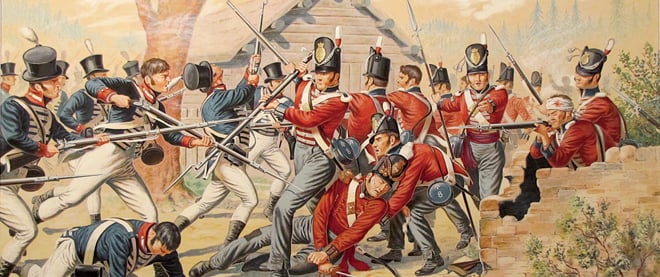What second sacking of York in the war of 1812?
A Toronto tourist destination rewrites the history to ignore the second sacking of York
Share

This week, Toronto unveiled its newest contribution to the War of 1812’s bicentenary. A meticulously researched “Book of Remembrance” lists all 181 British and American soldiers, native warriors and local militia who died in the Battle of York, as Toronto was originally known. This clash saw U.S. troops storm ashore near present-day Exhibition Place—capturing the British fort and later burning and plundering much of the town.
“We wanted to be solemn and respectful of the dead on both sides,” notes city curator Wayne Reeves. “There was no ramp ceremony for these soldiers, they were generally buried where they fell.” Along with the gathered names, the exhibit Finding the Fallen: The Battle of York Remembered also features a variety of newly revealed artifacts from the battleground, many of which show the destructive impact of the massive explosion that ripped through Fort York’s powder magazine at the end of the fight.
But as one arm of Toronto goes to great lengths to remember precisely what happened 200 years ago, another city-owned venue appears to be doing the exact opposite.
The Fort York Foundation operates the old fort as a tourist destination. And in a series of newspaper ads soliciting donations, the foundation has the following to say about its legacy: “On April 27, 1813, Toronto was invaded. Soldiers, citizens and First Nation warriors fought together in common cause. Fort York fell but rebuilding began almost immediately. And the Town of York was successfully defended throughout the rest of the War of 1812.”
But it’s simply not true to claim the town was “successfully defended” following that first raid. After sacking York in April, American invaders returned in force on July 31. As Canadian historian Pierre Berton recounts in his 1981 classic Flames Across the Border, those persistent Yankees then proceeded to “evacuate the town, burn the barracks, blockhouses and all other buildings at Gibraltar Point.” York was sacked again. So why would modern-day Toronto go to such an effort to recall its first invasion, while completely ignoring the second?
Curtis Barlow, executive director of the Fort York Foundation, bravely defends his version of history, claiming the fort wasn’t rebuilt until August 1813. “So technically speaking,” he says via email, the fort can’t be implicated in the July attack. Refiguring the facts in this way may also make for better ad copy. Even after 200 years, it seems truth is still a casualty of war.